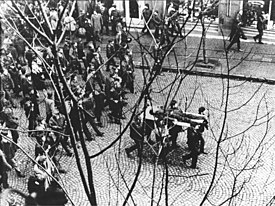Coastal cities events
| Polish 1970 protests | |||
|---|---|---|---|

Polish 1970 protests in Gdynia: the body of Janek Wiśniewski (real name Zbyszek Godlewski) is carried by the demonstrators.
|
|||
| Date | December 14–19, 1970 | ||
| Location | Gdańsk, Gdynia, Elbląg, Szczecin | ||
| Caused by | Massive increases in the prices of basic foodstuffs | ||
| Methods | Demonstrations | ||
| Parties to the civil conflict | |||
|
|||
| Lead figures | |||
|
|||
| Units involved | |||
|
|||
| Casualties | |||
|
|||
The Polish 1970 protests (Polish: Grudzień 1970) occurred in northern Poland in December 1970. The protests were sparked by a sudden increase of prices of food and other everyday items. As a result of the riots, which were put down by the Polish People's Army and the Citizen's Militia, at least 42 people were killed and more than 1,000 wounded.
In December 1970 the government suddenly announced massive increases in the prices of basic foodstuffs, especially dairy products after a bad harvest throughout the course of that year. The rise in prices proved to be a major shock to ordinary citizens, especially in the larger cities.
Demonstrations against the price rises broke out in the northern Baltic coastal cities of Gdańsk, Gdynia, Elbląg and Szczecin. Gomułka's right-hand man, Zenon Kliszko, made matters worse by ordering the army to fire on workers as they tried to return to their factories. The regime was afraid of a wave of sabotage that was being started, which however is often believed to be inspired by the secret police, who wanted to legitimize a harsh response to the protesters.
Another party leader, Stanisław Kociołek, appealed to the workers to return to work. However, in Gdynia the soldiers had orders to stop workers returning to work and on December 17 they fired into the crowd of workers emerging from their trains; hundreds of workers were killed or wounded. The protest movement then spread to other cities, leading to strikes and occupations. The government mobilized 5,000 members of special squads of police and 27,000 soldiers equipped with heavy tanks and machine guns. Over 1,000 people were wounded and at least 40 killed (other numbers often cited are 39 and 44 though the exact death toll remains unknown) and 3,000 arrested, by modern accounts. However, only six people were reported dead by the government at the time. All those who perished were buried overnight, with only the closest relatives present, in order to avoid spreading the riots.
...
Wikipedia
